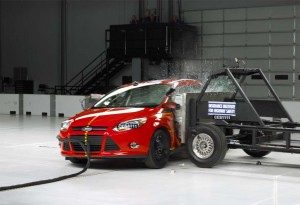When Ellen Pierson’s daughter was ready to get her license, the suburban New York mother of three fretted about what to let the high school student drive. “It had to be as safe as possible,” Pierson says, “so I began thinking something in a big SUV.”
Her daughter Lynn, on the other hand, wanted something hipper and, like many of today’s young drivers, something that was more environmentally friendly. She was eying a Ford Fiesta. Almost small enough to fit in the back of some of the big SUVs, mother Pierson was aghast – until she checked the crash tests and realized that the Fiesta was ranked right up there with some much bigger vehicles.
Told to chip in with some of the money she had earned over several summer vacations, Lynn got the car of her young dreams.
Ellen Pierson isn’t the only one surprised by what she has discovered about today’s new crop of small cars. Indeed, the Insurance Institute for Highway Safety has announced that six of the 13 compact vehicles it recently tested earned the industry-funded groups “Top Safety Pick.” None landed in the “poor” category in any of the four crash tests each vehicle is subjected to. The latest to earn the top ranking were the Ford Focus, Honda Civic, Hyundai Elantra, Nissan Juke, Toyota Prius and Lexus CT200h.
Adding the results of previous testing and 22 small cars now get the IIHS Top Safety Pick imprimatur. However, IIHS officials caution that automakers still have work ahead of them before some of the newest minicars on the road overcome safety concerns and qualify for top rankings.
“The list of cars with the best fuel economy now includes those with the highest crash test ratings in their class, too,” said David Zuby, the institute’s chief research officer. “At a time of high gasoline prices, consumers have never had a bigger selection of small cars that earn Top Safety Pick.”
Small cars are clearly gaining ground, now accounting for a quarter or more of U.S. auto sales, depending upon how you categorize various vehicles. Industry experts believe that fuel price concerns have shifted the market substantially, Ford’s President of the Americas Mark Fields listing fuel economy as one of the top factors considered by drivers today. But Fields also sees safety as a critical factor.
And traditional fears linger in a market that has long been motivated by the mantra “bigger is better.”
There’s no question, says analyst George Peterson, that “the laws of physics haven’t changed.” And in a collision between a 5,000-pound SUV and a 2,500 minicar the smaller model will have to yield ground. But today’s small cars have generally been designed to use physics to a motorist’s advantage.
Influenced by the safety cages used in Formula One and other high-speed motor sports series, new vehicles are designed to channel crash forces around the passenger compartment. Multiple airbags, collapsing pedals and self-tightening seatbelts further reduce the risk of injury or death. (Meanwhile, proponents often argue that small cars can be made more nimble, allowing a driver to avoid an accident as opposed to a large and lumbering SUV.)
Such factors have yielded a dramatic improvement from 1997, when the IIHS first tested 11 small cars. None earned a top rating, three landing in the “poor” category.
Still, the smaller the car the tougher it is to reach the levels that will earn a Top Safety Pick. For the moment, the new Ford Fiesta is the only vehicle to qualify in what the IIHS calls the minicar class. And the pint-sized Chevrolet Aveo is one of the lowest-rated cars the institute has tested.
But “as automakers introduce new minicars we expect more top safety picks in that category,” said IIHS spokesman Russ Rader.

